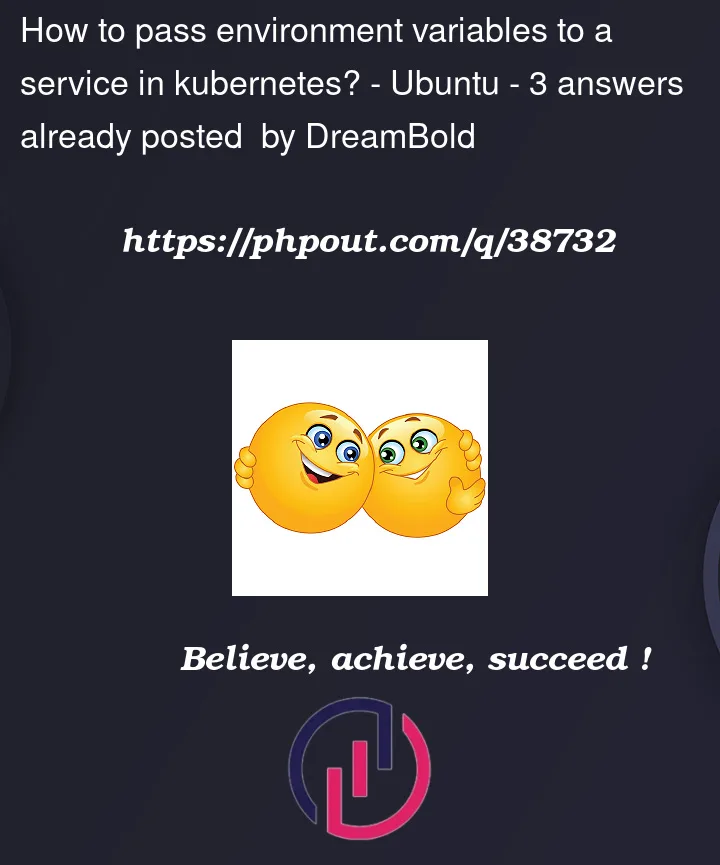I have configured minikube and am trying to run kubenetes on my local ubuntu machine.
When I build the MongoDB docker image on my local, I can pass the env variables this way and it works well with the backend API:
mongo_db:
image: mongo:latest
container_name: db_container
environment:
- MONGODB_INITDB_DATABASE=contacts
- MONGO_INITDB_ROOT_USERNAME=root
- MONGO_INITDB_ROOT_PASSWORD=password
ports:
- 27017:27017
volumes:
- ./mongodb_data_container:/data/db
But when I try to run the entire application(frontend, backend, and MongoDB) in Kubernetes, how do I initiate the MongoDB with the env variables so the backend API can connect to the database pod instance? I’m pulling latest mongodb instance, here’s the mongo-deployment yaml file:
# MongoDB Deployment - Database
apiVersion: apps/v1
kind: Deployment
metadata:
name: mongo
spec:
selector:
matchLabels:
app: mern-stack
replicas: 1
template:
metadata:
labels:
app: mern-stack
spec:
containers:
- name: mern-stack
image: mongo:latest
ports:
- containerPort: 27017
volumeMounts:
- name: db-data
mountPath: /data
readOnly: false
volumes:
- name: db-data
persistentVolumeClaim:
claimName: mern-stack-data
I have tried to pass the env variables this way, but it doesn’t seem to work:
...
volumeMounts:
- name: db-data
mountPath: /data
readOnly: false
env:
- name: MONGODB_INITDB_DATABASE
value: "contacts"
- name: MONGO_INITDB_ROOT_USERNAME
value: "root"
- name: MONGO_INITDB_ROOT_PASSWORD
value: "password"
...
What’s the quick solution? Should I try config map and secret eventually?




3
Answers
If you have not already, run the following command to execute all kubectl commands in the namespace you created:
or you can choose to use a Base64-encoded password:
To learn about your options for secret storage, see https://kubernetes.io/docs/concepts/configuration/secret/
Change these values to yours.
stringData.password #Plaintext password for the desired user.
data.password #Base64-encoded password for the desired user.
Save the User Secret file with a .yaml extension
Create MongoDBUser
When you create a new MongoDB database user, Kubernetes Operator automatically creates a new Kubernetes secret. The Kubernetes secret contains the following information about the new database user:
username: Username for the database userpassword: Password for the database userconnectionString.standard: Standard connection string that can connect you to the database as this database user.connectionString.standardSrv: DNS seed list connection string that can connect you to the database as this database user.For more details, you can visit here
volumeMounts usually used for the whole config file e.g. ***.conf
It’s more convenient for you to use secret in your case.
1、create secret resource
2、you can use in your mongodb
You can populate a container’s environment variables through the use of Secrets or ConfigMaps. Use Secrets when the data you are working with is sensitive (e.g. passwords), and ConfigMaps when it is not.
In your Pod definition specify that the container should pull values from a Secret:
You can now define two different Secrets, one for production and one for dev.
dev-secret.yaml:
prod-secret.yaml:
And deploy the correct secret to the correct Kubernetes cluster:
Now whenever a Pod starts it will populate its environment variables from the values specified in the Secret.